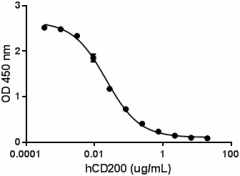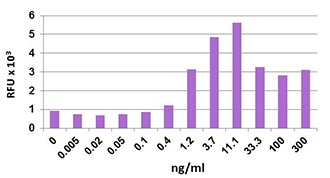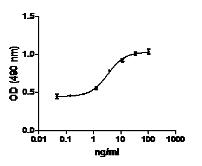- Regulatory Status
- RUO
- Other Names
- OX-2 membrane glycoprotein, OX-2, OX2, MRC OX-2, MOX1, MOX2, My033
- Ave. Rating
- Submit a Review
- Product Citations
- publications

-

IC50= 0.01 – 0.04 µg/mL as measured in a competition binding assay where increasing concentration of unlabeled human CD200 was able to competitively displace binding of biotinylated human CD200 (50 ng/mL) to immobilized human CD200R1. -

Human CD200 was aliquoted in PBS, pH 7.2 at 0.2 mg/ml. One aliquot was freeze and thawed four times (4x freeze/thaws), and compared to a control kept at 4°C (control). The samples were tested in a competition binding assay with biotinylated human CD200.
CD200 (OX-2) is a 45 kD cell surface glycoprotein that belongs to the immunoglobulin superfamily (IgSF). CD200 is composed of 202 amino acid extracellular domain containing two IgSF domains, 27 amino acid transmembrane segment, and a 19 amino acid cytoplasmic domain. CD200 is the only known ligand of the CD200R family and it is highly conserved in the CNS, expressed mainly by neurons and vascular endothelium. It is also present in most peripheral cell types, thymocytes, T and B cells, and dendritic cells. CD200 and CD200R interact with each other through N-terminal IgSF domains. Their interaction plays important roles in negatively regulating immune responses, and attenuating autoimmune diseases and excessive inflammatory responses against pathogens. High expression of CD200 in CNS is thought to be a mechanism of constitutive immune suppression, and is developmentally regulated in the mouse brain. Deficiency in neuronal CD200 may explain the chronic inflammation in human neurodegenerative diseases such as Alzheimer, Parkinson, and multiple sclerosis. CD200 and CD200R interaction has also been shown to play an important role in the regulation of anti-tumor immunity, and overexpression of CD200 has been reported in a number of malignancies, including CLL, as well as on cancer stem cells.
Product DetailsProduct Details
- Source
- Human CD200, amino acids Gln31-Gly232 (Accession # P41217) with a C-terminal human IgG1 Fc and 6-His tag was expressed in 293E cells.
- Molecular Mass
- The 446 amino acid recombinant protein has a predicted molecular mass of approximately 50 kD. The DTT-reduced protein migrates at approximately 65 kD and and non-reduced protein migrates at approximately 130 kD by SDS-PAGE. The predicted N-terminal amino acid is Gln.
- Purity
- >95%, as determined by Coomassie stained SDS-PAGE.
- Formulation
- 0.22 µm filtered protein solution is in PBS, pH 7.2
- Endotoxin Level
- Less than 0.1 EU per µg protein as determined by the LAL method.
- Concentration
- 10 and 25 µg sizes are bottled at 200 µg/mL. 100 µg size and larger sizes are lot-specific and bottled at the concentration indicated on the vial. To obtain lot-specific concentration and expiration, please enter the lot number in our Certificate of Analysis online tool.
- Storage & Handling
- Unopened vial can be stored between 2°C and 8°C for up to 2 weeks, at -20°C for up to six months, or at -70°C or colder until the expiration date. For maximum results, quick spin vial prior to opening. The protein can be aliquoted and stored at -20°C or colder. Stock solutions can also be prepared at 50 - 100 µg/mL in appropriate sterile buffer, carrier protein such as 0.2 - 1% BSA or HSA can be added when preparing the stock solution. Aliquots can be stored between 2°C and 8°C for up to one week and stored at -20°C or colder for up to 3 months. Avoid repeated freeze/thaw cycles.
- Activity
- IC50= 0.01 – 0.04 µg/mL as measured in a competition binding assay where increasing concentration of unlabeled human CD200 was able to competitively displace binding of biotinylated human CD200 (50 ng/mL) to immobilized human CD200R1.
- Application
-
Bioassay
- Application Notes
-
BioLegend carrier-free recombinant proteins provided in liquid format are shipped on blue-ice. Our comparison testing data indicates that when handled and stored as recommended, the liquid format has equal or better stability and shelf-life compared to commercially available lyophilized proteins after reconstitution. Our liquid proteins are verified in-house to maintain activity after shipping on blue ice and are backed by our 100% satisfaction guarantee. If you have any concerns, contact us at tech@biolegend.com.
Antigen Details
- Structure
- Disulfide-linked homodimer
- Distribution
-
Neurons and vascular endothelium in CNS, and most peripheral cell types, thymocytes, T and B cells, and dendritic cells.
- Function
- Costimulates T-cell proliferation. May regulate myeloid cell activity in a variety of tissues.
- Interaction
- Mast cells, basophils, macrophages, and dendritic cells
- Ligand/Receptor
- CD200R
- Bioactivity
- Measured in a competition binding assay with biotinylated human CD200.
- Biology Area
- Cell Biology, Immunology, Neuroscience, Neuroscience Cell Markers, Costimulatory Molecules
- Molecular Family
- CD Molecules, Soluble Receptors
- Antigen References
-
1. Hernangomez M, C. et al. 2014. Curr Pharm Des. 20:4707-22.
2. Walker DG, Lue LF. 2013. Future Neurol. 10.2217/fnl.13.14.
3. Wright GJ, et al. 2003. J Immunol. 171: 3034-46.
4. Vaine CA, Soberman RJ. 2014. Adv Immunol. 121:191-211.
5. Minas K, et al. 2006. Crit Rev Immunol. 26(3): 213-30.
6. Wang XJ, et al. 2007. J Neuroimmune Pharmacol. 2(3): 259-64.
7. Wong KK, et al. 2010. J Leukoc Biol. 88(2): 361-72. - Gene ID
- 4345 View all products for this Gene ID
- UniProt
- View information about CD200 on UniProt.org
Related Pages & Pathways
Pages
Related FAQs
- Why choose BioLegend recombinant proteins?
-
• Each lot of product is quality-tested for bioactivity as indicated on the data sheet.
• Greater than 95% Purity or higher, tested on every lot of product.
• 100% Satisfaction Guarantee for quality performance, stability, and consistency.
• Ready-to-use liquid format saves time and reduces challenges associated with reconstitution.
• Bulk and customization available. Contact us.
• Learn more about our Recombinant Proteins. - How does the activity of your recombinant proteins compare to competitors?
-
We quality control each and every lot of recombinant protein. Not only do we check its bioactivity, but we also compare it against other commercially available recombinant proteins. We make sure each recombinant protein’s activity is at least as good as or better than the competition’s. In order to provide you with the best possible product, we ensure that our testing process is rigorous and thorough. If you’re curious and eager to make the switch to BioLegend recombinants, contact your sales representative today!
- What is the specific activity or ED50 of my recombinant protein?
-
The specific activity range of the protein is indicated on the product datasheets. Because the exact activity values on a per unit basis can largely fluctuate depending on a number of factors, including the nature of the assay, cell density, age of cells/passage number, culture media used, and end user technique, the specific activity is best defined as a range and we guarantee the specific activity of all our lots will be within the range indicated on the datasheet. Please note this only applies to recombinants labeled for use in bioassays. ELISA standard recombinant proteins are not recommended for bioassay usage as they are not tested for these applications.
- Have your recombinants been tested for stability?
-
Our testing shows that the recombinant proteins are able to withstand room temperature for a week without losing activity. In addition the recombinant proteins were also found to withstand four cycles of freeze and thaw without losing activity.
- Does specific activity of a recombinant protein vary between lots?
-
Specific activity will vary for each lot and for the type of experiment that is done to validate it, but all passed lots will have activity within the established ED50 range for the product and we guarantee that our products will have lot-to-lot consistency. Please conduct an experiment-specific validation to find the optimal ED50 for your system.
- How do you convert activity as an ED50 in ng/ml to a specific activity in Units/mg?
-
Use formula Specific activity (Units/mg) = 10^6/ ED50 (ng/mL)
 Login / Register
Login / Register 













Follow Us